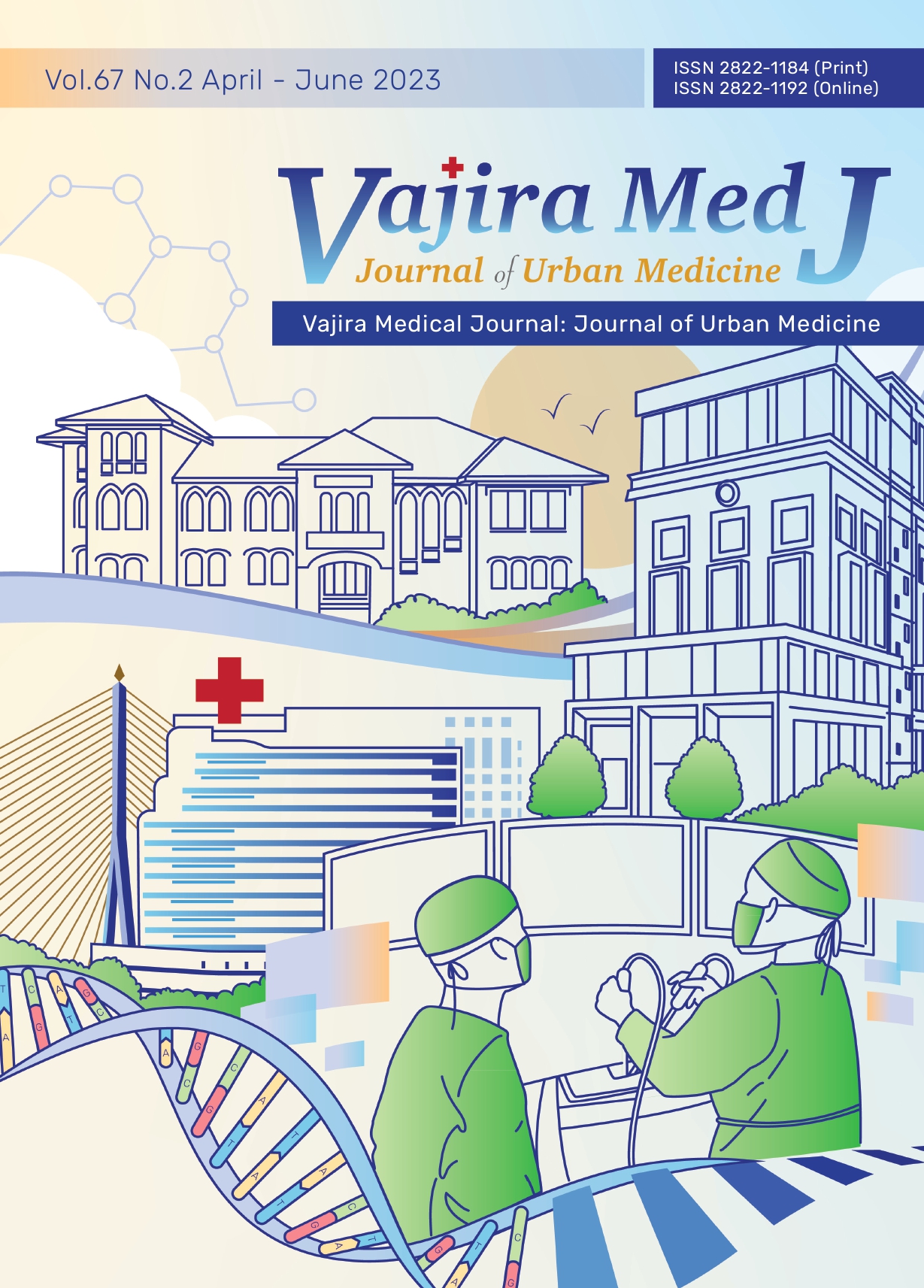Incidence of Percutaneous Nephrostomy Tube-Associated Urinary Tract Infections in Vajira Hospital Percutaneous Nephrostomy Tube-Associated Infections
Main Article Content
Abstract
OBJECTIVE: To study the incidence of percutaneous nephrostomy tube-associated urinary tract infection (PCNI), changes in urinary characteristics, and factors associated with PCNI.
METHODS: A chart review was performed to retrospectively collect data on patients who underwent percutaneous nephrostomy (PCN) insertion for the first time. The eligibility criteria were met by 103 patients. PCNI incidence and correlation, changes in urinary characteristics and infectious events following insertion, bacterial characteristics, and the relationship between the type of bacteria and the presence of symptoms were all investigated.
RESULTS: The incidences of PCNI, sepsis, pyuria, and bacteriuria after insertion were 25.2%, 14.5%, 61.1%, and 48.5% within 76, 67, 25, and 46 days, respectively. The most common bacteria were multi-drug-resistant Escherichia coli (MDR E. coli) (16.2%), Pseudomonas aeruginosa (P. aeruginosa) (11.7%), Escherichia coli (E. coli) (10.3%), and Enterococcus faecalis (E. faecalis) (10.3%), which were susceptible to carbapenem, piperacillin/tazobactam, and amikacin. The bacterial type and PCNI demonstrated no correlation. However, the frequency of PCN change, indwelling period, pyuria, and bacteriuria in chronic kidney disease was significantly correlated with PCNI (p < 0.05).
CONCLUSION: Quarter of patients with a PCN catheter develops PCNI. More than half of patients with PCN indwellers had pyuria or bacteriuria. E. coli has the most significant ratio. Carbapenem, piperacillin/tazobactam, and amikacin all had benefits but should be adjusted in terms of culture results, especially in the multi-drug resistance group. The incidence of PCNI may decrease with early diagnosis, drainage, and the shortest period before specific treatment in the future.
Downloads
Article Details

This work is licensed under a Creative Commons Attribution-NonCommercial-NoDerivatives 4.0 International License.
References
Goodwin WE, Casey WC, Woolf W. Percutaneous trocar (needle) nephrostomy in hydronephrosis. J Am Med Assoc 1955;157(11): 891-4.
Camúñez F, Echenagusia A, Prieto ML, Salom P, Herranz F, Hernández C. Percutaneous nephrostomy in pyonephrosis. Urol Radiol 1989;11(2):77-81.
Naeem M, Jan MA, Ullah A, Ali L, Khan S, Haq A ul, et al. Percutaneous nephrostomy for the relief of upper urinary tract obstruction: an experience with 200 cases. J Postgrad Med Inst 2010;24(2).
Radecka E, Magnusson A. Complications associated with percutaneous nephrostomies. A retrospective study. Acta Radiol 2004;45(2): 184-8.
Singer M, Deutschman CS, Seymour CW, Shankar-Hari M, Annane D, Bauer M, et al. The third international consensus definitions for sepsis and septic shock (sepsis-3). Jama 2016;315(8):801-10.
Ramanathan R, Duane TM. Urinary tract infections in surgical patients. Surg Clin North Am 2014;94(6):1351-68.
Lara-Isla A, Medina-Polo J, Alonso-Isa M, Benitez-Sala R, Sopena-Sutil R, Justo-Quintas J, et al. Urinary infections in patients with catheters in the upper urinary tract: microbiological study. Urologia internationalis 2017;98(4):442-8.
Szvalb AD, El Haddad H, Rolston KV, Sabir SH, Jiang Y, Raad II, et al. Risk factors for recurrent percutaneous nephrostomy catheter-related infections. Infection 2019;47(2):239-45.
Bahu R, Chaftari AM, Hachem RY, Ahrar K, Shomali W, El Zakhem A, et al. Nephrostomy tube related pyelonephritis in patients with cancer: epidemiology, infection rate and risk factors. J Urol 2013;189(1):130-5.
El Haddad H, Viola G, Jiang Y, Raad I, Rolston KV, Szvalb A. Percutaneous nephrostomy tube-related infections. Open Forum Infectious Diseases 2017;4(Suppl 1):s349.
Maramara B, Psevdos G, Lobo Z. A ten-year review of urinary tract infections in patients with indwelling nephrostomy tubes. Open Forum Infect Dis 2016;3 Suppl 1:1322.
Dienstmann R, da Silva Pinto C, Pereira MT, Small IA, Ferreira CG. Palliative percutaneous nephrostomy in recurrent cervical cancer: a retrospective analysis of 50 consecutive cases. J Pain Symptom Manage 2008;36(2):185-90.
Cronan JJ, Horn DL, Marcello A, Robinson A, Paolella LP, Lambiase RE, et al. Antibiotics and nephrostomy tube care: preliminary observations. Part II. Bacteremia. Radiology 1989;172(3 Pt 2):1043-5.
Pappas P, Stravodimos KG, Mitropoulos D, Kontopoulou C, Haramoglis S, Giannopoulou M, et al. Role of percutaneous urinary diversion in malignant and benign obstructive uropathy. J Endourol 2000;14(5):401-5.
Wagenlehner FME, Bjerklund Johansen TE, Cai T, Koves B, Kranz J, Pilatz A, et al. Epidemiology, definition and treatment of complicated urinary tract infections. Nat Rev Urol 2020;17(10):586-600.
Kozyrakis D, Kratiras Z, Soukias G, Chatzistamou SE, Zarkadas A, Perikleous S, et al. Clinical outcome and prognostic factors of sepsis, septic shock and prolonged hospitalization, of patients presented with acute obstructive pyelonephritis. J Endourol 2020;34(4):516-22.
Tambyah PA, Oon J. Catheter-associated urinary tract infection. Curr Opin Infect Dis 2012;25(4):365-70.
Thanos L, Mylona S, Stroumpouli E, Kalioras V, Pomoni M, Batakis N. Percutaneous CT-guided nephrostomy: a safe and quick alternative method in management of obstructive and nonobstructive uropathy. J Endourol 2006;20(7):486-90.
Kutcher R, Rosenblatt R. Sonographically guided percutaneous renal interventional procedures. JAMA 1984;251(23):3126-9.
Batura D, Gopal Rao G. A systematic review of the clinical significance of nephrostomy urine cultures. World J Urol 2020;38(1):45-55.
Steven S, Safriadi F. Bacterial and antibiotic sensitivity patterns in patient urine after percutaneous nephrostomy. Majalah Kedokteran Bandung 2021;53(3):155-62.


